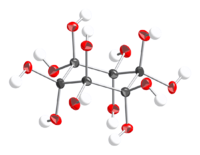- Dodécahydroxycyclohexane
-
Dodécahydroxycyclohexane 

Général Nom IUPAC cyclohexane-1,1,2,2,3,3,4,4,5,5,6,6-dodécol Synonymes cyclohexanedodécol No CAS PubChem SMILES InChI Propriétés chimiques Formule brute C6H12O12 [Isomères] Masse molaire[1] 276,1523 ± 0,0092 g·mol-1
C 26,1 %, H 4,38 %, O 69,52 %,Unités du SI & CNTP, sauf indication contraire. Le dodécahydroxycyclohexane est un composé organique de formule C6O12H12 ou C6(OH)12. C'est le sextuple diol géminal du cyclohexane qui peut être aussi considéré comme le sextuple hydrate de la cyclohexanehexone, C6O6, un oxyde de carbone.
Dihydrate
Le dihydrate du dodécahydroxycyclohexane, C6O12H12·2H2O peut être cristallisé du méthanol sous forme de plaquettes incolores ou de prismes qui se décomposent vers 100 °C[2].
Ce composé a été synthétisé originellement en 1862 par J. Lerch[3] en oxydant du hexahydroxybenzène, C6(OH)6 ou de la tétrahydroxy-1,4-benzoquinone, C6(OH)4O2 et a été caractérisé par R. Nietzki et al. en 1885[4]. Cependant, ce composé a été pendant longtemps pensé être la cyclohexanehexone avec de l'eau de cristallisation, C6O6·8H2O.
Ainsi, ce produit est encore de nos jours communément appelé cyclohexanehexone octahydrate, hexacétocyclohexane octahydrate, triquinoyl octahydrate et autres noms similaires. Sa vraie nature était suspectées depuis 1950 et même avant[5] mais n'a été expérimentalement confirmée par analyses de diffractométrie de rayons X qu'en 2005[6].
Voir aussi
Notes
- (en) Cet article est partiellement ou en totalité issu de l’article de Wikipédia en anglais intitulé « Dodecahydroxycyclohexane » (voir la liste des auteurs)
- Masse molaire calculée d’après Atomic weights of the elements 2007 sur www.chem.qmul.ac.uk.
- Alexander J. Fatiadi, Horace S. Isbell, William F. Sager, Cyclic Polyhydroxy Ketones. I. Oxidation Products of Hexahydroxybenzene (Benzenehexol), Journal of Research of the National Bureau of Standards A: Physics and Chemistry, 1963, vol. 67A(2), pp. 153–162.
- Jos. Ud. Lerch, Ueber Kohlenoxydkalium und die aus demselben darstellbaren Säuren, J. Prakt. Chem., 1862, vol. 87(1), pp. 427–469. DOI:10.1002/prac.18620870146.
- R. Nietzki, Th. Benckiser, Ueber Hexaoxybenzolderivate und ihre Beziehungen zur Krokonsäure und Rhodizonsäure, Berichte der deutschen chemischen Gesellschaft, 1885, vol. 18(1), pp. 499–515. DOI:10.1002/cber.188501801110.
- Willis B. Person, Dale G. Williams, Infrared spectra and the structures of leuconic acid and triquinoyl, J. Phys. Chem., 1957, vol. 61(7), pp. 1017–1018. DOI:10.1021/j150553a047.
- Thomas M. Klapötke, Kurt Polborn, Jan J. Weigand, Dodecahydroxycyclohexane dihydrate, Acta Crystallographica, Section E - Structure Reports, 2005.
Wikimedia Foundation. 2010.

